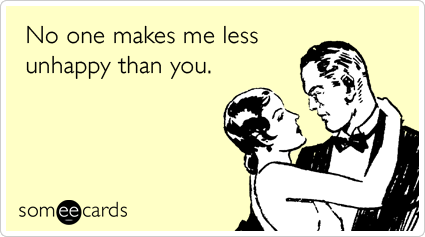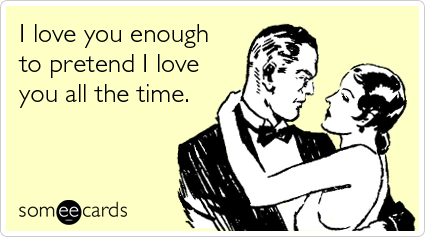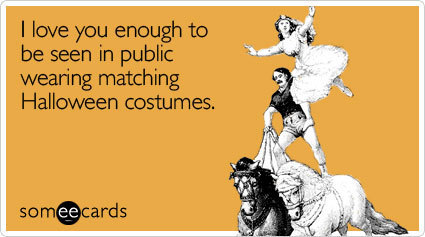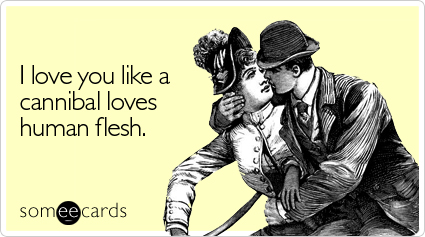Funny I Love You Ecards Definition
Source(Google.com.pk)
The love theory definition of love is quadripartic: four definitions can be read as one sentence. I have alluded to three of these earlier. The fourth, given below, will surely be the most controversial, but it can best be understood in relation to the other three. Following, therefore, is the love theory general definition of love:Part One -- Theologically, Love is God (and vice versa).Part Two -- Metaphysically, love is a movement of the will toward that which is perceived as good. 20Part Three -- Psychologically, love is simultaneously the fundamental drive and goal of human life, the push and pull of every human act, the raw force from which is derived and toward which is aimed, all emotion, all thought, all volition (will), and all behavior.
Part Four -- Materially, physically, love is the fundamental "spiritual substance" from which the atom, the building block of all material reality, was created; as such, love remains in the atom as the elemental dynamic force, flux, medium, ether or energy that binds together and governs the functioning of every electron, proton, neutrino, quark and yet-to-be-found subatomic microparticle and of every movement of the macrocosmic physical universe. In short, love is reality.This quadruplex definition obviously moves love a quantum leap beyond the romance-, emotion-, biological and relationship-centered ways in which it has been typically defined. Yet, it refutes no one. Love is all the things that all the theorists, all the scientists, all the poets, all that thousands of other writers have said it is. It is just more -- far, far more.
So does this definition of love satisfy that task of describing the whole elephant, the entire empire, or on the contrary, does this four-dimensional definition, sweeping as it obviously is, still capture only a few facets of love, something less than the entire diamond? It has taken me forty years to write that definition.
During my many years of helping couples, both in pre-marital and marital counseling, there is one theory of “love” I’ve use over and over again to help everyone in the room learn to speak the same language about this ultimately important, yet incredibly confusing word. This theory, called the “Triangle Theory of Love,” was developed by Dr. Robert Sternberg, a Psychologist at Tufts University.
In a nutshell, the Triangular Theory of Love defines “love” as being composed of 3 qualities, passion, intimacy, and commitment. These 3 components can be defined as follows:The friendship or specialness of the relationship. The feelings of closeness, bondedness, connectedness, trust, and friendship in the relationship.The excitement or energy of the relationship. The feelings of physical attraction, romance, and arousal (particularly sexual arousal) in the relationship.The “business aspect” of the relationship. This includes all the shared investments, or the “history,” of the relationship, such as decisions, experiences, and adjustments.Passion tends to develop very quickly in relationships, followed by a gradual deterioration over time. Intimacy tends to increase somewhat quickly at first, then tapers off, growing more slowly for a time before finally leveling off. Commitment always starts at ground zero and increases over time for the duration of the relationship.As can be seen in the picture at the beginning of this article, these 3 components of love can be viewed as comprising the 3 sides of a triangle, with Commitment as the base, and Passion and Intimacy comprising the upper 2 sides. Depending on how much of each of these 3 components is present, a triangle can either be very small or very large. Also, although the picture of the triangle shown above depicts love as an equilateral triangle, it is seldom seen in this form. Depending on how much of each of the components is present, the sides of the triangle are often unequal. For example, in a brand new relationship, Passion is likely to be the longest side of the triangle while the Intimacy and Commitment sides are likely to be substantially shorter, thus creating an isosceles triangle.
As described above, the 3 sides of the triangle are shortened or lengthened according to the amount of each component present in the relationship. Biologically, love is a powerful neurological condition like hunger or thirst, only more permanent. We talk about love being blind or unconditional, in the sense that we have no control over it. But then, that is not so surprising since love is basically chemistry. While lust is a temporary passionate sexual desire involving the increased release of chemicals such as testosterone and oestrogen, in true love, or attachment and bonding, the brain can release a whole set of chemicals: pheromones, dopamine, norepinephrine, serotonin, oxytocin and vasopressin. However, from an evolutionary perspective, love can be viewed as a survival tool – a mechanism we have evolved to promote long-term relationships, mutual defence and parental support of children and to promote feelings of safety and security.
Since love has been the topic of countless articles, books, discussions, and sleepless nights, I might as well explain how I got interested. I have long been addicted to popular songs, especially love songs. They play in my head, usually uninvited, and often at odd hours. Some of them show up from out of a dim past, so I am frequently searching for lyrics to fill gaps in my memory.
Several years ago in the course of looking for a lyric, perhaps the one quoted above, I happened upon an extraordinary website called Lyrics World (now defunct). What was unusual about this site was that it contained the Top Forty popular songs for the last 70 years (1930-2000), over ten thousand lyrics. As I began to read lyrics of love songs at random, it seemed to me that the majority of them fell into only three patterns: infatuation, requited love, and heartbreak. There were also romance lyrics which didn’t fit, but in any given year, they were never in the majority.
The study I later did (Chapter 5) confirmed: about a quarter of all pop songs in the Top 40, year after year, are about heartbreak, about a tenth, about infatuation, and about a tenth, about requited love. Another fourth involves miscellaneous kinds of romance, and a little more than a fourth are not about love or romance.
But in reading these lyrics, a new question arose. It seemed to me that none of these three forms, often not even requited love, suggested genuine love. However, in order to state this idea with confidence, I would have to find out, at least to my own satisfaction, what I mean by genuine love. At least in English, the one word covers so many different things as to be almost meaningless. Of all the emotion words, I think that love may be the broadest and the most vague and pliable. The pliability of this word results in many problems, both in scholarship and in real life.
For this reason I propose a concept of love that is bio-social-psychological: genuine love, in its non-erotic form, has a physical basis in attachment, and a social psychological basis in attunement (shared awareness and identity). Romantic love involves a second physical basis: (sexual) attraction. Each of these forms in itself can involve very intense feelings. Combinations of two or three forms can lead to overwhelming feelings. Non-erotic love is intense because it conjoins attachment emotions and genuine pride. The added experience of sexual desire in erotic love means a powerful confluence of three feelings, each intense alone.
Part Four -- Materially, physically, love is the fundamental "spiritual substance" from which the atom, the building block of all material reality, was created; as such, love remains in the atom as the elemental dynamic force, flux, medium, ether or energy that binds together and governs the functioning of every electron, proton, neutrino, quark and yet-to-be-found subatomic microparticle and of every movement of the macrocosmic physical universe. In short, love is reality.This quadruplex definition obviously moves love a quantum leap beyond the romance-, emotion-, biological and relationship-centered ways in which it has been typically defined. Yet, it refutes no one. Love is all the things that all the theorists, all the scientists, all the poets, all that thousands of other writers have said it is. It is just more -- far, far more.
So does this definition of love satisfy that task of describing the whole elephant, the entire empire, or on the contrary, does this four-dimensional definition, sweeping as it obviously is, still capture only a few facets of love, something less than the entire diamond? It has taken me forty years to write that definition.
During my many years of helping couples, both in pre-marital and marital counseling, there is one theory of “love” I’ve use over and over again to help everyone in the room learn to speak the same language about this ultimately important, yet incredibly confusing word. This theory, called the “Triangle Theory of Love,” was developed by Dr. Robert Sternberg, a Psychologist at Tufts University.
In a nutshell, the Triangular Theory of Love defines “love” as being composed of 3 qualities, passion, intimacy, and commitment. These 3 components can be defined as follows:The friendship or specialness of the relationship. The feelings of closeness, bondedness, connectedness, trust, and friendship in the relationship.The excitement or energy of the relationship. The feelings of physical attraction, romance, and arousal (particularly sexual arousal) in the relationship.The “business aspect” of the relationship. This includes all the shared investments, or the “history,” of the relationship, such as decisions, experiences, and adjustments.Passion tends to develop very quickly in relationships, followed by a gradual deterioration over time. Intimacy tends to increase somewhat quickly at first, then tapers off, growing more slowly for a time before finally leveling off. Commitment always starts at ground zero and increases over time for the duration of the relationship.As can be seen in the picture at the beginning of this article, these 3 components of love can be viewed as comprising the 3 sides of a triangle, with Commitment as the base, and Passion and Intimacy comprising the upper 2 sides. Depending on how much of each of these 3 components is present, a triangle can either be very small or very large. Also, although the picture of the triangle shown above depicts love as an equilateral triangle, it is seldom seen in this form. Depending on how much of each of the components is present, the sides of the triangle are often unequal. For example, in a brand new relationship, Passion is likely to be the longest side of the triangle while the Intimacy and Commitment sides are likely to be substantially shorter, thus creating an isosceles triangle.
As described above, the 3 sides of the triangle are shortened or lengthened according to the amount of each component present in the relationship. Biologically, love is a powerful neurological condition like hunger or thirst, only more permanent. We talk about love being blind or unconditional, in the sense that we have no control over it. But then, that is not so surprising since love is basically chemistry. While lust is a temporary passionate sexual desire involving the increased release of chemicals such as testosterone and oestrogen, in true love, or attachment and bonding, the brain can release a whole set of chemicals: pheromones, dopamine, norepinephrine, serotonin, oxytocin and vasopressin. However, from an evolutionary perspective, love can be viewed as a survival tool – a mechanism we have evolved to promote long-term relationships, mutual defence and parental support of children and to promote feelings of safety and security.
Since love has been the topic of countless articles, books, discussions, and sleepless nights, I might as well explain how I got interested. I have long been addicted to popular songs, especially love songs. They play in my head, usually uninvited, and often at odd hours. Some of them show up from out of a dim past, so I am frequently searching for lyrics to fill gaps in my memory.
Several years ago in the course of looking for a lyric, perhaps the one quoted above, I happened upon an extraordinary website called Lyrics World (now defunct). What was unusual about this site was that it contained the Top Forty popular songs for the last 70 years (1930-2000), over ten thousand lyrics. As I began to read lyrics of love songs at random, it seemed to me that the majority of them fell into only three patterns: infatuation, requited love, and heartbreak. There were also romance lyrics which didn’t fit, but in any given year, they were never in the majority.
The study I later did (Chapter 5) confirmed: about a quarter of all pop songs in the Top 40, year after year, are about heartbreak, about a tenth, about infatuation, and about a tenth, about requited love. Another fourth involves miscellaneous kinds of romance, and a little more than a fourth are not about love or romance.
But in reading these lyrics, a new question arose. It seemed to me that none of these three forms, often not even requited love, suggested genuine love. However, in order to state this idea with confidence, I would have to find out, at least to my own satisfaction, what I mean by genuine love. At least in English, the one word covers so many different things as to be almost meaningless. Of all the emotion words, I think that love may be the broadest and the most vague and pliable. The pliability of this word results in many problems, both in scholarship and in real life.
For this reason I propose a concept of love that is bio-social-psychological: genuine love, in its non-erotic form, has a physical basis in attachment, and a social psychological basis in attunement (shared awareness and identity). Romantic love involves a second physical basis: (sexual) attraction. Each of these forms in itself can involve very intense feelings. Combinations of two or three forms can lead to overwhelming feelings. Non-erotic love is intense because it conjoins attachment emotions and genuine pride. The added experience of sexual desire in erotic love means a powerful confluence of three feelings, each intense alone.
Funny I Love You Ecards Photos Pictures Pics Images 2013

Funny I Love You Ecards Photos Pictures Pics Images 2013

Funny I Love You Ecards Photos Pictures Pics Images 2013

Funny I Love You Ecards Photos Pictures Pics Images 2013

Funny I Love You Ecards Photos Pictures Pics Images 2013

Funny I Love You Ecards Photos Pictures Pics Images 2013

Funny I Love You Ecards Photos Pictures Pics Images 2013

Funny I Love You Ecards Photos Pictures Pics Images 2013

Funny I Love You Ecards Photos Pictures Pics Images 2013

Funny I Love You Ecards Photos Pictures Pics Images 2013

No comments:
Post a Comment